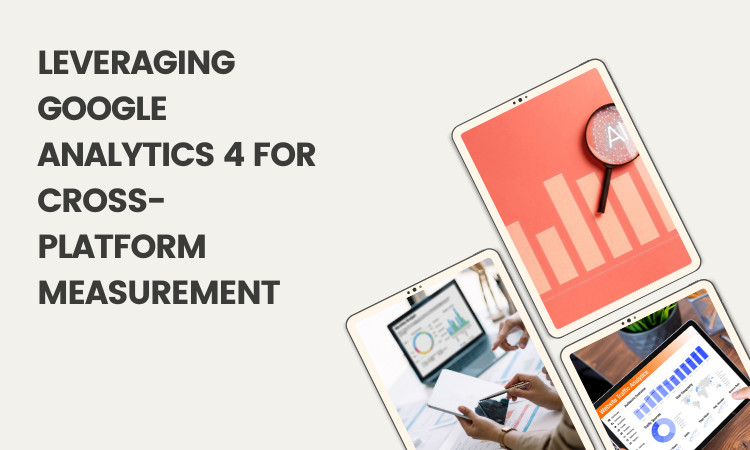In the era of multi-device and multi-channel interactions, understanding user behavior across various platforms has become crucial for businesses to make informed decisions. Google Analytics 4 (GA4) is a powerful analytics tool that offers advanced capabilities for cross-platform measurement. It allows businesses to gain comprehensive insights into user interactions across websites, mobile apps, and other digital platforms. This blog will explore how you can leverage Google Analytics 4 for cross-platform measurement to enhance your data-driven decision-making process.
Set Up a Unified Property
To achieve effective cross-platform measurement, setting up a unified property in Google Analytics 4 is crucial. This involves creating a single property that can collect data from multiple sources, such as websites, Android and iOS apps, and other digital platforms. By centralizing your data in one property, you can better understand the entire customer journey and interactions across different touchpoints.
Enable User ID Tracking
Enabling User ID tracking is essential for accurate cross-platform measurement. User ID tracking allows you to associate user interactions across various devices and platforms with a unique identifier. By assigning a User ID to authenticated users, you can track their activity as they move between devices, providing valuable insights into their behavior and preferences.
Implement Enhanced Measurement
GA4 offers enhanced measurement capabilities that automatically track user interactions without the need for manual event tracking. Enable enhanced measurement to capture events such as page views, scroll depth, outbound clicks, video engagement, and more. By enabling this feature, you can quickly gather valuable data on user behavior across various devices and channels.
Utilize App + Web Properties
It also introduces the concept of App + Web properties, which allows you to combine data from both mobile apps and websites into a single property. This unified approach enables cross-platform measurement and facilitates a seamless understanding of user behavior across various touchpoints. Implementing App + Web properties can provide valuable insights into user journeys and conversion paths.
Leverage User Engagement Metrics
GA4 introduces new user engagement metrics such as user engagement rate, engagement time, and engaged sessions. These metrics provide a deeper understanding of how users interact with your content across various platforms. By analyzing user engagement metrics, you can identify areas of improvement, optimize user experiences, and tailor your marketing strategies accordingly.
Utilize Funnel Analysis
Funnel analysis in GA4 amp enables you to visualize and analyze the user journey, from initial touchpoints to conversion. Setting up funnel steps lets you track how users progress through specific actions or events across platforms. This helps identify bottlenecks in the conversion process and optimize user flows, improving overall performance.
Create Custom Audiences
Leverage GA4’s custom audiences feature to create segments of users based on specific behaviors or attributes. This allows you to target specific user groups with personalized marketing campaigns across different platforms. By understanding user preferences and segmenting your audience effectively, you can deliver more relevant and tailored experiences, leading to higher conversion rates.
Create Custom Events and Parameters
Custom events and parameters allow you to track specific actions and interactions unique to your business. Define meaningful events and parameters that align with your cross-platform measurement goals. For example, track user registrations, purchases, form submissions, or other actions representing critical conversion points.
Integrate with Other Platforms
GA4 allows integration with other platforms and tools to enhance cross-platform measurement. For example, connect GA4 with Google Ads to gain insights into ad performance and optimize your advertising campaigns. Integrations with other analytics tools or customer relationship management (CRM) systems can further enrich your data and provide a more comprehensive view of user interactions.
Enable E-commerce Tracking
For businesses with online stores, enabling e-commerce tracking in Google Analytics 4 is crucial for understanding sales performance across platforms. Measure transaction data, revenue, and product performance to gain valuable insights into your customers’ purchasing behaviors.
Regularly Analyze and Optimize
Cross-platform measurement is an ongoing process. Regularly analyze the event tracking GA4 data, identify trends, and uncover actionable insights. Use this information to refine your marketing strategies, optimize user experiences, and drive better results across platforms. Continuously measuring, analyzing, and optimizing is critical to staying ahead in the ever-evolving digital landscape.
Conclusion
Leveraging Google Analytics 4 for cross-platform measurement empowers businesses to gain a holistic view of user interactions and extract meaningful insights. By implementing GA4, enabling User ID tracking, utilizing enhanced measurement, and leveraging features such as App + Web properties, user engagement metrics, funnel analysis, custom audiences, and integrations with other platforms, businesses can optimize their marketing efforts and deliver personalized experiences across different touchpoints. Embrace the power of cross-platform measurement with GA4 to understand your audience better and drive business growth.


